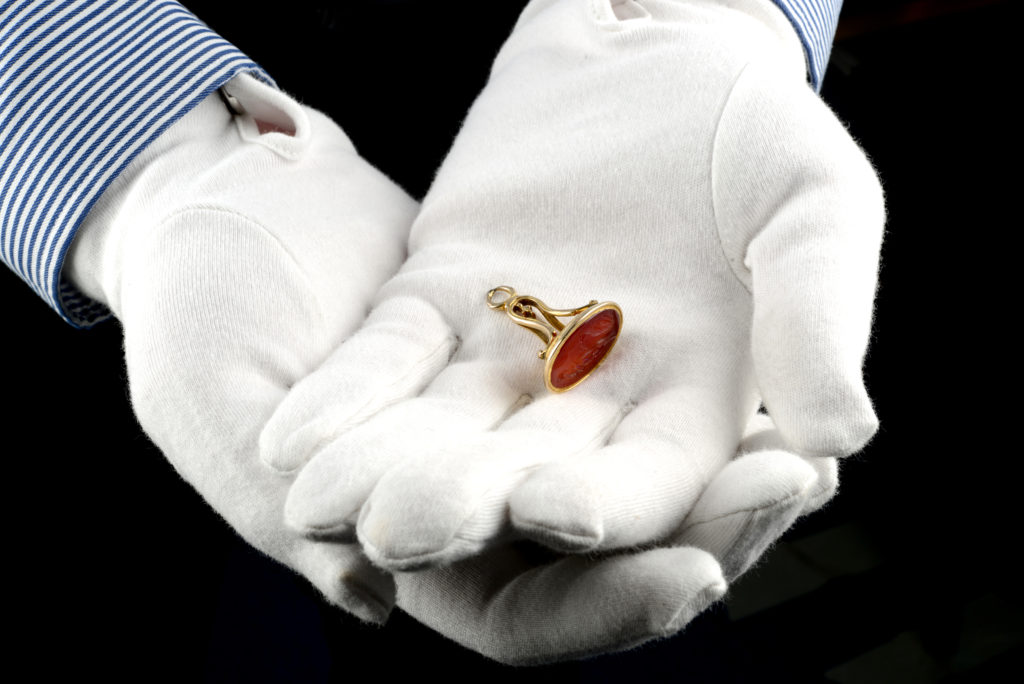William Brown (1748-1825) was a gem and seal engraver known for cameos and intaglios with classical scenes. We look at his work and the history of the intaglio from our previous Fine Jewellery auction.
William Brown and His Brother:
Brown worked alongside his brother Charles (1749-95). As both men often signed their work simply with ‘Brown’, it can be difficult to identify which was the sole work of which brother. However, in our case, Lot 701 is signed "W. Brown". William exhibited his intaglios and cameos at both the Society of Artists and the Royal Academy.
After the death of his brother, Charles in 1795, William then began to work almost exclusively on commissions from Catherine II of Russia. The empress employed his skills for over 10 years and filled her cabinets with carved stones. At one point her collection exceeded 400. Catherine was such a fan of carved stones, that in 1783 she ordered a set of reproductions from a Scottish modeller and engraver, James Tassie.
Tassie (1735-1799) sold paste reproductions of classical carved classical gems to many powerful and famous people in the eighteenth century. His collection was the most comprehensive of its day. In 1791, Erich Raspe compiled a catalogue of Tassie's vast collection. Over 15,000 items are listed in A Descriptive Catalogue of a General Collection of Ancient and Modern Engraved Gems, Cameos and Intaglios, Taken from the Most Celebrated Cabinets in Europe; and Cast in Coloured Pastes, White Enamel, and Sulphur. Nos. 1307 and 15132 from the Tassie collection bear a very similar resemblance to Lot 701.
William Brown at Auction:
In our recent Fine Jewellery auction that commenced on the 13th of April, there was a stunning collection of cameos and intaglios. They range from a variety of time periods, but Lot 701 is particularly charming. Lets see how it got on at auction...

Lot 701 - 13/4/23
A late Georgian gold carnelian intaglio of Hebe feeding Zeus as an eagle, by William Brown.
Price Realised: £12,870.00
Carved by William Brown circa 1790, it came to us in an interesting manner. We discovered it when searching through a huge bag of miscellaneous jewellery. One of our specialists spotted a hint of red and immediately recognised it as an item of historical importance!
William Brown - Inspired by Antiquity:
Brown carved the carnelian with a sweet image from classical mythology. It shows Hebe feeding her father Zeus while in the guise of an eagle. This is one of the more popular ways in which we see Hebe presented. However, we do sometimes see her with Artemis and Hera, or dancing with the Muses alongside Apollo. Hebe was the goddess of youth and the divine wife of Heracles.
In classical mythology, she had the power to restore youth to mortals – a power which only she had. Revered by the other gods, Hebe was the youngest. Her duty was to keep them divine and ageless. Among other roles, she was also the cupbearer for the Olympians. She often appears in art with amphorae and serving nectar or ambrosia. In our example, she takes on the role of cupbearer as she feeds her father. Eagles were associated with immortality, so we can assume that this is why Zeus takes this form when pictured with her.
While being depicted in a variety of ancient art, Hebe was not a popular subject in post-classical art until 1750. During this time, images of her exploded and became particularly popular, with Marie-Antoinette being painted in her likeness. Alongside his signature, William inscribed INV'T on the piece. This was implying that this was his own original design. So, while it might bear similarities to ancient examples, this composition was individual to William.













